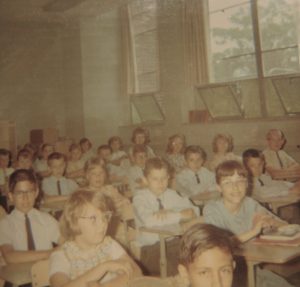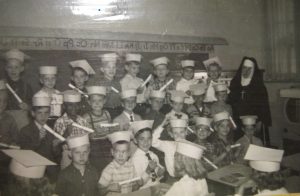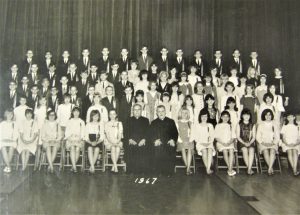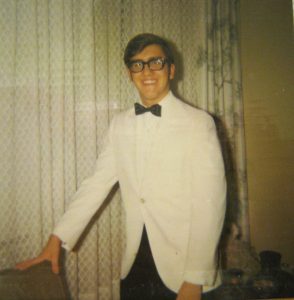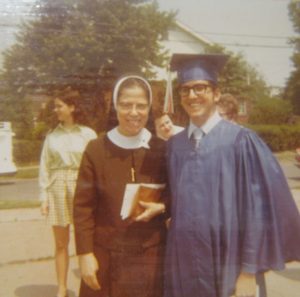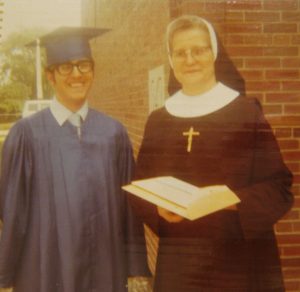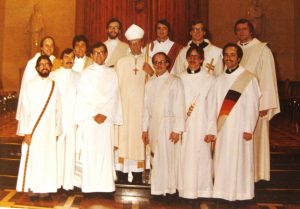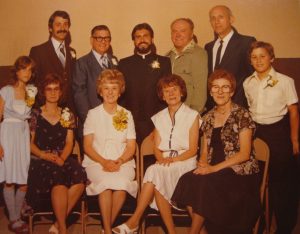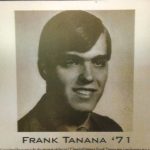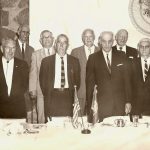Firmly Rooted:
Rev. Gary Michalik:
His Life, His Work, And His Ministry
Early Life
Gary Michael Michalik was born in Dearborn, Michigan, on the border of Detroit, at a clinic near Wyoming and Michigan Avenue. At the time, his parents, Joseph and Stella Michalik, were living in Detroit at 5910 Florida Street, between Kirkwood and Wagner and Proctor and Central Streets.
All four of Fr. Gary’s grandparents immigrated to the United States from Poland. Sebastian and Bernice Michalik, Fr. Gary’s paternal grandparents, were from an area outside of Kraków. They emigrated before World War I and were married at St. Hedwig Catholic Church at 3245 Junction Street on Detroit’s west side.
Fr. Gary’s maternal grandparents, Mary and Joseph Nowak, came from a region that today is part of the city of Warsaw. Back then, it was farmland that was just outside of Warsaw. They, too, were married in the United States.
Joseph and Stella Michalik were married at St. Cunegunda Catholic Church, in the original old wooden church on Detroit’s west side, in January of 1942. Joseph served in the United States Army in the South Pacific, where he was wounded in the Philippines. He sustained a gunshot wound to the inner elbow area of his arm and was subsequently shipped home to recover.
At that time, the Veterans Hospital was in Battle Creek, Michigan. Stella took the train from the Michigan Central Station to visit him while he was recovering in the hospital.
After Joseph returned home, he and Stella moved into their house on Florida Street and became members of St. Andrew Catholic Church at 7060 McGraw Street. Stella was from St. Cunegunda Parish, and Joseph was from St. Hedwig Parish but moved to Our Lady Queen of Angels Parish. When Joseph and Stella got married, they wanted to join a parish with both a grade and a high school, and St. Andrew, which was in between their two parishes, had both.
Joseph found employment with Chrysler Corporation’s Lynch Road Plant on Mount Elliott Street and Lynch Road on Detroit’s east side. He worked on the assembly line where he installed torsion bars. John Bunda, a neighbor down the street from the Michaliks, also worked at the plant, and Joseph rode with him to work. Joseph remained at Chrysler for 31 or 32 years.
Joseph and Stella had two sons. Their firstborn, Ronald, was born on August 28, 1946. Gary, the youngest—who would become Rev. Gary Michalik—was born on February 22, 1953. Stella was a homemaker until Gary was in high school, at which time she started working as a lunch mother at Priest School, the local public school. From there, she went to J. L. Hudson’s warehouse on the south side of Warren Avenue near Schaefer and Chase, where she worked in pricing. Several women in the neighborhood who were members of St. Andrew Parish worked at the Hudson’s warehouse, and they rode to work together.
There were many advantages to working at Hudson’s. Employees received a 20 percent discount on all merchandise. On Employee Appreciation Days, they received an additional 10 percent discount. Sometimes the Michaliks shopped at the downtown Hudson’s store or at the Budget Store on Michigan Avenue and Greenfield.
Life centered around the church and their faith. St. Andrew church and school were only four blocks from home, so the family always walked to church and school. Stella sang in the choir and was a member of the Women’s Guild and the Festival Committee. Joseph was an usher and a money counter and was also a member of the St. Vincent de Paul Society.
The Michalik family always sat in the same pew facing the altar, on the right side, three pews from the front. In front of them was a huge votive display. As a young boy, when Fr. Gary was bored during Mass, he counted the number of candles that were burning and compared them to those that were not burning. Later, he had his St. Joseph Missal, which was written in Latin on one side and English on the other, to keep him occupied. It also contained pictures. Today, he still has his First Communion missal.
Fr. Gary never served as an altar boy, although he did volunteer to be one. He attended the first class, but when he discovered that the classes were being taught in Latin, he dropped out. His brother Ron was not an altar boy, either.
In the Michalik home, the family celebrated Polish customs and traditions, especially Wigilia, which began with sharing the opłatek wafer. They enjoyed the customary meatless Wigilia meal.
The family always went to church to have their food blessed at Easter. Resurrection Mass was at 5:30 A.M. on Easter because children, including the young Gary Michalik, were in the procession. In that pageant, the children carried pots of lilies.
For the May procession, every child carried a full-stemmed gladiolus, also known as a sword lily. Fr. Gary recalled that as the children processed, they would poke each other in the ears with the tips of the gladiolus until the nun caught them and put an end to their antics.
During the school year at St. Andrew, the children’s Mass took place at 9:15 A.M. every Sunday. Children’s parents took them to the school building to be marked present. After Mass, their parents picked them up.
Growing up, Fr. Gary’s family was very close to his grandparents, and they visited them often, especially at Christmas and Easter, but also throughout the year. Since neither of them drove, the Michaliks visited them at their houses. The time was spent with Fr. Gary’s parents (and, at times, aunts and uncles) in conversation with them while the kids spent the time playing. Unfortunately, Sebastian Michalik, Fr. Gary’s paternal grandfather, died during World War II, and Joseph Nowak, his maternal grandfather, passed away in 1955. Thus, Fr. Gary did not get a chance to know them. Both his grandmothers spoke very little English as they were immigrants from Poland, so he did not have a close personal relationship with them.
Stella was a good cook and baker. She cooked all the traditional Polish dishes, American dishes, and soups, and she baked cakes, pies and cookies. Every meal was homemade, and the biggest meal of the week was on Sunday, with two or three meats and side dishes.
When Fr. Gary was growing up, the family never went out for a meal. The first meal he remembered having with his parents at a restaurant was when he was a freshman in high school. Because their house did not have air conditioning, meals in the summertime were simpler, or they got carry-outs from local fast food restaurants. Stella would say, “It’s too hot to cook.”
When Fr. Gary was young, like most kids, he was a fussy eater. As an example, when he was very young and Stella made homemade chicken soup and homemade noodles, he wouldn’t eat her noodles, so she had to buy packaged noodles for him. Today, Fr. Gary looks back and says, “What was wrong with me? Today I’d give anything to have her homemade noodles!”
Later, he enjoyed all his mother’s cooking and baking, and he ate just about whatever she made, with one possible exception. As he stated, “Well, except for liver and onions.”
Although Stella was an excellent cook and baker, Fr. Gary didn’t learn to cook from her or from his grandmothers. However, because his brother later became a Detroit firefighter who many times cooked at the firehouse, Stella taught him how to cook all her Polish meals, which were a big hit with the other firefighters. That was a benefit for the family as well because today, Ron continues to cook Stella’s recipes for their family meals at holidays.
There were several corner grocery stores and bakeries within close walking distance of the Michalik home: Hrapkiewicz Store (Florida and Kirkwood), Proctor Store (Proctor and Kirkwood), Al Forgiel’s Store (Chopin and Wagner), Proctor Bakery (Proctor and Kirkwood), and Tarnow Bakery (Tarnow and Wagner) were a few. The Tip-Top Inn, a popular local bar on Proctor and Kirkwood, was only nine houses away, so sometimes they went there for carry-out Friday fish dinners. For other shopping, such as for clothing, shoes, haircuts, prescriptions, dime stores, or for doctor’s appointments, they took about a 10-minute walk to the establishments on Michigan Avenue between Cecil and Central. Other shopping was done downtown or in Dearborn at Michigan Avenue and Schaefer.
Of course, the Michalik family celebrated birthdays, anniversaries, baptisms, and funerals. Quite often in the summertime they had family picnics at Hines Drive. Sometimes the picnics were held in Dearborn Heights or in Northville. Fr. Gary had an aunt and uncle who lived in Dearborn, and the Michaliks sometimes went with them to Camp Dearborn because at the time, only residents of Dearborn or their guests were allowed to use the facilities.
When Fr. Gary played with his friends, they played in the alley. They didn’t play formal baseball but rather a form of baseball. They played toy soldiers and cars and trucks, and they rode their bikes around the block “a million times.” They played in the Michaliks’ yard or in a neighbor’s yard. There were a lot of kids in the neighborhood at that time.
One neighbor lady, Mrs. Bomba, made her kids listen to the radio broadcast of Father Peyton’s Rosary Hour. Fr. Patrick Peyton, C.S.C., was known as the Rosary Priest. He began his mission in 1945 and fulfilled his calling to reach millions of people via the radio. He encouraged and inspired his audience to pray the rosary. He was known for using the medium of radio and garnering the support of Hollywood celebrities to fulfill his mission.
When Fr. Gary and his friends went out to play, they tried to avoid Mrs. Bomba’s back yard. If they got snared, they would all have to kneel at the sofa and pray the rosary—a fate as bad as reading the Latin missal.
As much as he avoided Mrs. Bomba and being forced to pray the rosary, Fr. Gary very much enjoyed playing Mass as a child. He went into his parents’ bedroom and used their dresser, putting a sheet over it to make an altar. The dresser had a big mirror on it, and he used a wooden stool for the tabernacle and a candelabra for candles. A wine glass served as a chalice.
At Christmas, there would always be extra opłatki because he would cut them, carving out round holes in them to be used as wafers for his Mass reenactments. Stella was a good seamstress, so she made vestments for the young Fr. Gary.
He was imitating what he saw in church, but subconsciously, those reenactments were probably Fr. Gary’s first leanings toward a calling to become a priest.
Both Ron and Fr. Gary graduated from St. Andrew High School, Ron graduating first. After high school, Ron worked at Ford Motor Company for a year or two and then was drafted into the U.S. Army during the height of the Vietnam War. Fortunately, he was assigned to Germany and not Vietnam. After returning home, he went back to work for Ford and then enrolled in the Detroit Fire Department Academy. He retired from the Detroit Fire Department.
Initially, Fr. Gary thought he wanted to be a teacher. After graduating from St. Andrew High School in 1971, he enrolled in classes at Wayne State University but dropped out after the first quarter. He then worked as a delivery person for a flower shop in Wyandotte for several months. From there, he went to work for one of his high school friends who owned his own flower shop in Detroit’s Warrendale district called Flowers by Tom, where he made deliveries.
Working for A. Mateja & Sons, College, and the Seminary
In the summer of 1973, Fr. Gary was hired by A. Mateja & Sons. At one point, he had returned to college and was attending the University of Detroit, so his boss, Chester Mateja, allowed him to work around his school schedule. He knew that he wanted a career in the church but wasn’t quite sure in what area. During the school year, he worked part-time and went to school full time. On Friday and Saturday, he worked at Mateja. He worked full time in the
summertime and continued working at Mateja until the summer of 1979. It was a fun place to work and provided him with spending money. It also got him acquainted with items that were used in churches.
Fr. Gary was a commuter student and lived at home during his college years. He became very active at St. Andrew Parish. He sang in the guitar group and parish choir, volunteered for fundraisers and at bingo and festivals, and served as a Eucharistic minister, as well as serving as a lector.
In his junior year at the University of Detroit, the Archdiocese of Detroit had a program called the Associate’s Program. It was for men and women who were not in a college seminary or convent but who were thinking about a vocation in the church as a priest or religious sister. They met monthly for socializing, prayer, and sharing.
At that time, Fr. Gary began to think about those times when he was a child and he used to play priest. He actually thought about being a priest when he was in the eighth grade and again when he was in the twelfth grade, but he kept pushing the thought aside.
Fr. Gary graduated from the University of Detroit with a degree in religious studies, a minor in philosophy, and a minor in history. Right after college, he applied to the St. John Provincial Seminary in Plymouth. He was accepted on the condition that he was going to try it out and see what it was like.
When Fr. Gary entered the seminary, it was his first time living away from home. On his first day, there was a Mass followed by a wine and cheese reception and then a formal dinner, which lasted until 8:00 P.M. He thought that seminary life would be great, not realizing that the first day and evening were no indication of what lay ahead.
It was in the middle of his second year in the seminary that Fr. Gary felt he had found his calling. He explained that when one is in the seminary, you go through what is called a formation. You have a spiritual director and a formation committee. They see if you are qualified to be a priest. It involves personal as well as academic formation. If it is determined that you are a candidate for the priesthood, you are enrolled into candidacy, meaning that you are adopted by the Archdiocese. Then they will pay for your tuition, and you remain with them.
Fr. Gary was ordained a transitional deacon in December of 1979 and was assigned to St. Agatha in Redford. His first year was an internship. Newly ordained deacons had two options available to them. The first was to serve at the parish for six months as a deacon and six months as a priest. The second option was to serve at the parish for 12 months as a deacon. Fr. Gary chose the first option.
He was ordained on June 21, 1980, and on July 1, 1981, he received his first assignment, which was at Our Lady Queen of Apostles in Hamtramck, where he remained for four years. In 1985, he was assigned to St. Mark in Warren, and in 1987, he became pastor of St. Stephen on Central Street in Detroit. He was at St. Stephen for six years when he was asked to return to Our Lady Queen of Apostles in Hamtramck as pastor. He remained there for five years and served there for a total of nine years.
After his last five years at Our Lady Queen of Apostles, he had been ordained for about 18 years. He had spent practically his entire life in the city. When St. Theodore in Westland opened up, he applied for the position and was assigned there. He stayed there for 12 years and then was assigned to St. Colette in Livonia, where he served for 13 years. He will retire from St. Colette in June of 2023 after serving as a priest for 43 years.
Sources:
- Michalik, Rev. Gary. Interview with the author. Livonia, MI: August 2, 2022
- Michalik, Rev. Gary. Email to the author. August 9, 2022
Photos:
- Gary Michalik’s fifth grade class at St. Andrew, ca. 1963. (He is not pictured in the photo)
- Gary Michalik’s St. Andrew grade school class, ca. 1959
- St. Andrew elementary school class of 1967
- Gary Michalik, all ready to go to a St. Andrew formal event, looking dapper in a white tuxedo jacket, ca. 1970
- Gary Michalik on his graduation day from St. Andrew High School, with Sr. Mary Presentine Ugorowski (Felician), June 17, 1971. Sr. Mary Presentine celebrated her 100th birthday in 2022.
- Gary Michalik with senior year teacher, Sr. M. Alberta
- Fr. Gary (first row, far left) with classmates after being ordained transitional deacons at St. John Seminary in Plymouth in 1979
- Fr. Gary with his family at the reception following his first Mass at St. Andrew Catholic Church in Detroit on June 22, 1980
- All photos from the collection of Rev. Gary Michalik
